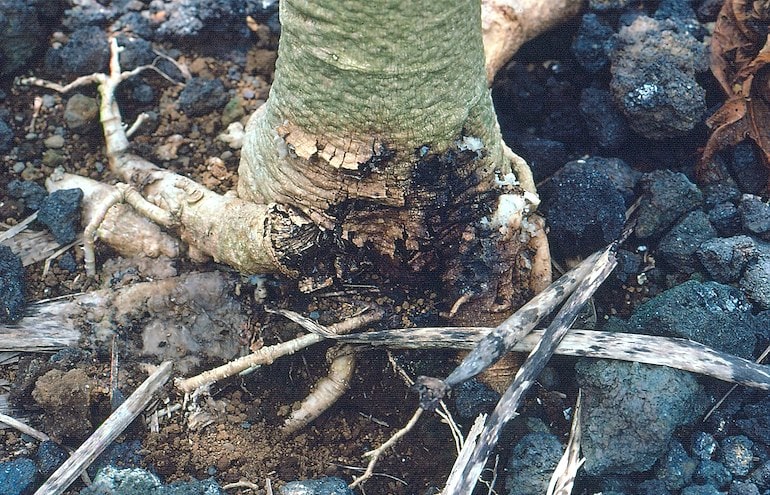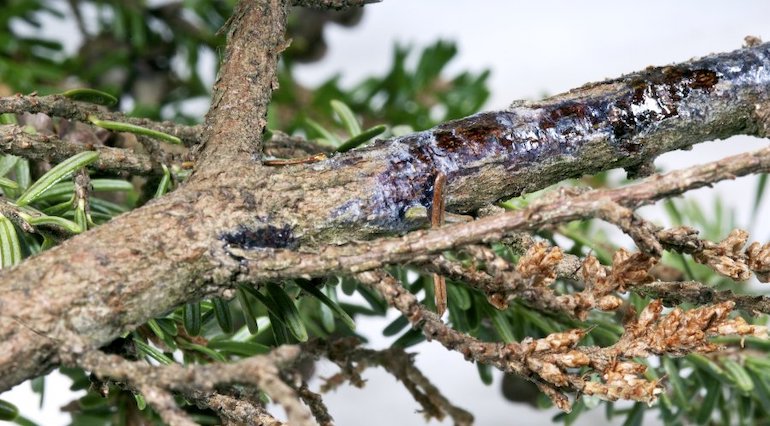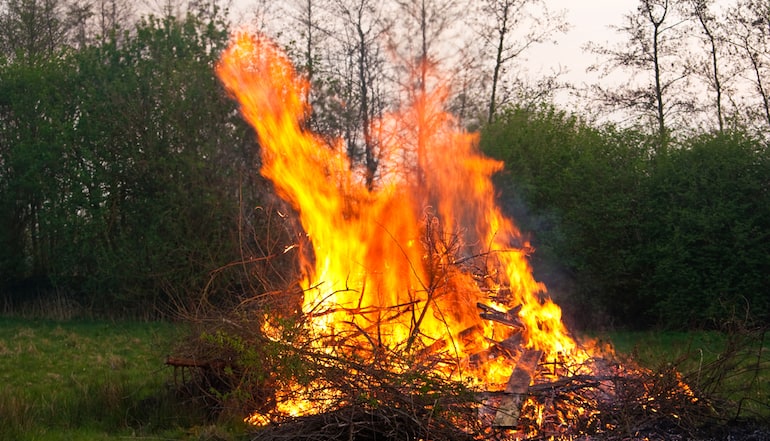Garden diseases - Phytophthora root rot

Most of the damage from Phytophthora root rot occurs beneath the surface
Image: Scot Nelson from Honolulu, Hawaii, USA, CC0, via Wikimedia Commons
Also called water mould, phytophthora ramorum is a fungus-like organism that spreads through infected water. Its various strains affect many species of trees and shrubs, border bedding, and pot plants, and crops. P. ramorum is often indistinguishable from signs of waterlogging and, because much of the damage occurs beneath the soil, often, by the time you spot signs of disease, it’s too late to save the plant.
Here’s how to identify P. ramorum, and what to do if you’re unlucky enough to find affected plants and trees.
What is Phytophthora ramorum?

Lesions on this conifer indicates P.ramorum disease
Image: © Crown Copyright. Forestry Commission
P.ramorum is a genus of oomycetes which are a major crop and tree killer worldwide. Although the spores travel mere millimeters under their own steam, when they’re present in the groundwater, they spread through groundwater and into river systems, infecting large areas. Once it penetrates plant root systems, p. ramorum causes rot which in turn affects nutrient take-up. Often the first you’ll know of a problem is when you notice yellowing and browning foliage and weak, poorly attached leaves – by which time, sadly, it’s too late to save the plant.
To add a layer of confusion, p.ramorum is a microscopic organism which, unlike say honey fungus, leaves no visible sign of itself, and because it usually occurs in wet areas, it’s often very hard to distinguish from the effects of waterlogging, and may only be positively identified via samples sent off to a laboratory.
Often, the symptoms are a scattered browning from the centre of the tree, working its way out along the branches. Conifers are particularly susceptible.
If you spot wilting leaves, or fading conifers and you suspect root rot, take a shovel and dig away a little of the soil to expose the roots. Depending on how advanced the infection is, feeder roots many have rotted away entirely while remaining roots appear brown and decayed. Often you will see a clear “tidemark” or collar below which the bark is dark and discoloured by rot.
What to do about phytophthora ramorum root rot

Destroy any infected material by burning
Image: Shutterstock
Because phytophthora is synonymous with waterlogging, improving drainage is a great way to vastly reduce the odds that your trees, shrubs, and other ornamental and crop plants will pick up an infection.
If you discover that you do indeed have p.ramorum, your best best is to remove any infected plants, and destroy them by burning. Don’t put diseased material in your compost or you’ll give the organism a place to lie dormant ready to attack new plants.
Be sure to disinfect any tools you use, as-well-as infected plant pots and containers.
Be careful when selecting plants to bring in from the garden centre, that there’s no sign of the disease. Be mindful of the fact that latent infection in plants brought in from outside is a potent source of infection.
If you’re planting in heavy, clay soil, perforate the edges of the planting hole to ensure good drainage.
Also bear in mind that p.ramorum can lie dormant in the soil for a considerable time – at least several years. If you want to replant sooner than that, your best bet is to remove and replace your topsoil, and replant with less susceptible strains.
Other pages you might like
See all pests & diseases guides
Individual guides
Diseases
- Apple scab
- Bacterial canker
- Blackleg
- Blossom wilt
- Botrytis
- Brown rot
- Clematis wilt
- Downy mildew
- Fungal disease
- Honey fungus
- Leaf scorch
- Leaf spot
- Leek rust
- Lily disease
- Peach leaf curl
- Pear rust
- Potato & tomato blight
- Powdery mildew
- Silver leaf fungus
- Tomato greenback
- Tomato leaf curl
- Tomato stem canker







